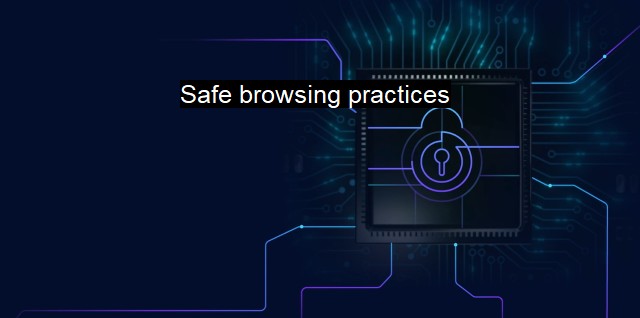What are Safe browsing practices?
Safe Browsing Practices: Key Concepts and Importance for Cybersecurity and Antivirus Software
Safe browsing practices refer to a collection of guidelines that work together to create the best possible way to use the internet without entailing a security risk. Applying these practices in daily online surfing makes it difficult for cybercriminals to exploit vulnerabilities, thus effectively protecting valuable or sensitive information from breaches or unauthorized access.Many might argue that attaining a high level of internet security is as good as installing top-of-the-line antivirus software and setting stronger passwords, and then you are good to go. In many ways, they are right. the complete approach to online safety includes safe browsing practices that encompass system maintenance, internet usage habits, personal identification, and online transactions.
Safe browsing practices start by ensuring that all the programs, software, and applications installed on your computer are consistently updated, and operating systems aren't left behind either. Developers regularly improve these tools by plugging security gaps, adding new features, and patching solutions to known and exploitable bugs. By keeping your system and applications updated, you can ensure safety from common security threats.
Using strong and unique passwords is another aspect of safe browsing practices. Unfortunately, most internet users still keep easy-to-guess passwords for convenience and have a habit of using the same password across different platforms. This creates a backdoor for cyberattacks, and once one platform gets infiltrated, others follow suit. Therefore, to stay safe online, use unique, complex passwords and consider using password management tools.
A critical and often ignored practice involves verifying the legitimacy of websites visited. An essential rule of thumb is to check whether the site uses HTTPS with an SSL certificate rather than the insecure HTTP. A locked padlock icon usually appears before the URL, indicating that the connection is secure. Avoid providing personal and financial information on websites lacking such security parameters.
Everyone must maintain caution while downloading content from the internet. While it may appear harmless to download documents, music, software, or movies, downloading from unreliable sources may be a gateway to downloading malware unintentionally. Such malware can expose your computer’s files, gather private data, or cause harm to system performance.
With phishing attacks becoming increasingly sophisticated, recognizing emails from impostors or suspicious enterprises can play a significant role in maintaining your online safety. Hence, avoid opening emails from untrusted sources and never click on email links or download attachments from suspicious emails.
Cybersecurity is complemented significantly by using firewalls and antivirus software. Firewalls act as protective barriers between your private network and the internet, scrutinizing traffic entering and exiting your network. Antivirus software detects and eliminates harmful programmes, often even before you realize you were a potential target. they need to be perpetually updated to stay prepared for the ever-evolving threats.
Privacy configurations on social media platforms are essential and often underrated elements of internet safety. Sharing personal, sensitive information including contact details or location, can be a potential hazard. Therefore, carefully control what you share on such platforms and be sure to review and adjust privacy settings accordingly.
Though internet use is an irreplaceable part of work and personal life, it poses numerous threats, and cybercriminals consistently evolve their techniques. Therefore, practicing safe internet browsing is of paramount importance today. From the basic steps of keeping software updated and using complex passwords to more in-depth strategies such as critically analyzing every download and email received promotes a safer internet experience.
Safe browsing practices, combined with adequate antivirus and firewall protection, can enhance the security of personal and work devices and data. These habits, when consistently practiced, can fortify your digital barriers, making it difficult for potential hackers to infiltrate. Above all, they can safeguard against the dire implications of compromised security, ensuring confidential data remains where it belongs.
Browsing safely requires constant awareness and vigilance, yet it goes a long way in ensuring personal and professional data's integrity against cyber threats.

Safe browsing practices FAQs
What are safe browsing practices?
Safe browsing practices are habits and behaviors that help protect you from cyber threats while browsing the internet. These practices include using strong passwords, keeping your software up to date, avoiding suspicious links, and using antivirus software.Why is it important to practice safe browsing?
Practicing safe browsing is important because it can help prevent cyber attacks such as phishing, malware infections, and identity theft. These attacks can cause serious damage to your computer and compromise your personal and financial information.What are some common safe browsing tips?
Some common safe browsing tips include not opening email attachments from unknown senders, avoiding unsecured or suspicious websites, using two-factor authentication, and being cautious with pop-up ads. It's also important to keep your antivirus software up to date and to regularly scan your computer for malware.What should I do if I think my computer has been compromised?
If you believe your computer has been compromised, disconnect it from the internet immediately and run a virus scan. You should also change your passwords for all accounts, monitor your financial statements, and consider freezing your credit. It's important to get professional help to remove any malware before you reconnect to the internet.| | A | | | B | | | C | | | D | | | E | | | F | | | G | | | H | | | I | | | J | | | K | | | L | | | M | |
| | N | | | O | | | P | | | Q | | | R | | | S | | | T | | | U | | | V | | | W | | | X | | | Y | | | Z | |
| | 1 | | | 2 | | | 3 | | | 4 | | | 7 | | | 8 | | |||||||